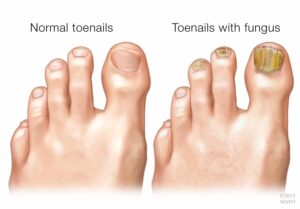To trim and soften hard fungal nails is often a difficult task. The changes that toenail fungus causes specifically can make this task more difficult than for other people. Toenail fungus is normally an aesthetic issue, which only causes a change in how the toenail looks. However, there are functional issues that can arise from this type of infection as well. Many patients, for example, struggle with toenail fungus and feel like their nails are too hard or thick to cut. Regular grooming of the nail can become impaired by these functional detriments. Overgrowth can make the appearance of the nail deteriorate aesthetically even faster as the nail grows excessively long.
Healthy Nails
Trimming healthy nails should be effortless. There is a certain look that is associated with healthy nails. These nails will appear clear and expose the pink or brown skin underneath them. A healthy nail will be thin, consistent texturally, and not detached from the nail bed at all. A healthy nail won’t have any debris buildup under the nail. They won’t have cracks on the surface of the nail. The nail should grow at a reasonable rate and have enough structure to, but still, be soft enough to trim without a problem.
Hard Fungal Nails Symptoms
Hard fungal nails are just one of many symptoms of toenail fungus symptoms that can be assessed. The most common symptom is nail discoloration. The first signs of this discoloration will usually show up as a small dot or stripe on the surface of the toenail. As the toenail fungus infection progresses without effective treatment, the discoloration will grow. When the fungus is left untreated for a long period of time, the entire nail can often become covered in the color.
Other damages can happen to the nail aside from discoloration. Some other common symptoms include nail brittleness, cracking, and detachment from the nail bed. Some of the most frustrating changes include the thickening and hardening of the nail. This poses a unique concern as it affects the ability to groom the nails effectively. When grooming is affected in this way, it is necessary to take other measures to trim the nails regularly.

What happens if the fungus is left untreated
Hard fungal nails will need to be trimmed frequently in accordance with good hygiene practices. Long nails can pose many issues for health. For example, overly long toenails can harbor bacteria under them that can lead to other infections. Extremely long toenails will also increase the risk of forming ingrown toenails. Long toenails break very easily, and broken toenails tend to have jagged edges that tear into the skin of the toe easily. Long toenails are also often uncomfortable and push up against the shoe as you walk and stand. Excessively long toenails will be detrimental to your toe and nail health down the line.
For patients with hard fungal nails, letting the nail grow out may seem inevitable or unavoidable. Sometimes getting nail clippers to trim the nail effectively can be impossible because the fungus can make the nails hard to cut through. Even if the fungus isn’t making the nail become harder, the nail can still become thickened because of toenail fungus. Nail clippers may not even fit over nails that have become excessively thick.
What can be done at home?
Softening hard fungal nails is essential to their regular maintenance so that you can avoid the functional difficulties of a very hard or thick nail. The only way to permanently fix a nail that has become thickened or hardened from toenail fungus is to fix the fungal infection itself. However, there are simple ways to help maintenance in the meantime. Using a foot soak to soften nails is an accessible and effective way to groom hard nails. This is an easy method that can be done at home.
Instructions to soften hard fungal nails
Fill a container with enough warm water to completely cover your feet, and soak your nails for 20-40 minutes. After soaking, try to trim them again. If the nails are still not trimmable, you can try soaking your toes again daily until they’re soft enough to cut. If your nail is particularly thick, you can try buffing off some of the nail’s thickness with a nail file or nail buffing tool as well.
While soaking the feet is helpful at trimming hard fungal nails, the best thing to do in this situation is to be seen by a licensed nail doctor near you. They will be able to provide effective care for the fungus, and hopefully treat the fungal infection itself once and for all. To learn more about this treatment or schedule a free consultation with a licensed podiatrist, give us a call at 1-(800) 672-0625 or visit our website for more information.



